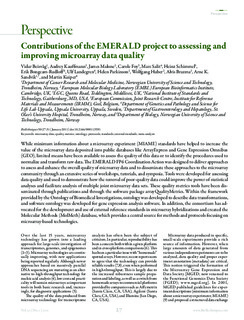| dc.contributor.author | Beisvag, Vidar | |
| dc.contributor.author | Kauffmann, Audrey | |
| dc.contributor.author | Malone, James | |
| dc.contributor.author | Foy, Carole | |
| dc.contributor.author | Salit, Marc | |
| dc.contributor.author | Schimmel, H | |
| dc.contributor.author | Bongcam-Rudloff, Eric | |
| dc.contributor.author | Landegren, Ulf | |
| dc.contributor.author | Parkinson, Helen | |
| dc.contributor.author | Huber, Wolfgang | |
| dc.contributor.author | Brazma, Alvis | |
| dc.contributor.author | Sandvik, Arne Kristian | |
| dc.contributor.author | Kuiper, Martin | |
| dc.date.accessioned | 2019-08-29T07:37:09Z | |
| dc.date.available | 2019-08-29T07:37:09Z | |
| dc.date.created | 2011-06-30T10:04:14Z | |
| dc.date.issued | 2011 | |
| dc.identifier.citation | BioTechniques. 2011, 50 (1), 27-31. | nb_NO |
| dc.identifier.issn | 0736-6205 | |
| dc.identifier.uri | http://hdl.handle.net/11250/2611512 | |
| dc.description.abstract | While minimum information about a microarray experiment (MIAME) standards have helped to increase the value of the microarray data deposited into public databases like ArrayExpress and Gene Expression Omnibus (GEO), limited means have been available to assess the quality of this data or to identify the procedures used to normalize and transform raw data. The EMERALD FP6 Coordination Action was designed to deliver approaches to assess and enhance the overall quality of microarray data and to disseminate these approaches to the microarray community through an extensive series of workshops, tutorials, and symposia. Tools were developed for assessing data quality and used to demonstrate how the removal of poor-quality data could improve the power of statistical analyses and facilitate analysis of multiple joint microarray data sets. These quality metrics tools have been disseminated through publications and through the software package arrayQualityMetrics. Within the framework provided by the Ontology of Biomedical Investigations, ontology was developed to describe data transformations, and software ontology was developed for gene expression analysis software. In addition, the consortium has advocated for the development and use of external reference standards in microarray hybridizations and created the Molecular Methods (MolMeth) database, which provides a central source for methods and protocols focusing on microarray-based technologies. | nb_NO |
| dc.language.iso | eng | nb_NO |
| dc.publisher | Future Medicine | nb_NO |
| dc.relation.uri | Contributions of the EMERALD project to assessing and improving microarray data quality | |
| dc.rights | Attribution-NonCommercial-NoDerivatives 4.0 Internasjonal | * |
| dc.rights.uri | http://creativecommons.org/licenses/by-nc-nd/4.0/deed.no | * |
| dc.title | Contributions of the EMERALD project to assessing and improving microarray data quality | nb_NO |
| dc.type | Journal article | nb_NO |
| dc.type | Peer reviewed | nb_NO |
| dc.description.version | publishedVersion | nb_NO |
| dc.source.pagenumber | 27-31 | nb_NO |
| dc.source.volume | 50 | nb_NO |
| dc.source.journal | BioTechniques | nb_NO |
| dc.source.issue | 1 | nb_NO |
| dc.identifier.doi | 10.2144/000113591 | |
| dc.identifier.cristin | 827673 | |
| dc.description.localcode | Creative Commons Attribution Non-Commercial No Derivatives License | nb_NO |
| cristin.unitcode | 194,65,15,0 | |
| cristin.unitcode | 1920,15,0,0 | |
| cristin.unitcode | 194,66,10,0 | |
| cristin.unitname | Institutt for klinisk og molekylær medisin | |
| cristin.unitname | Medisinsk klinikk | |
| cristin.unitname | Institutt for biologi | |
| cristin.ispublished | true | |
| cristin.fulltext | original | |
| cristin.qualitycode | 1 | |

